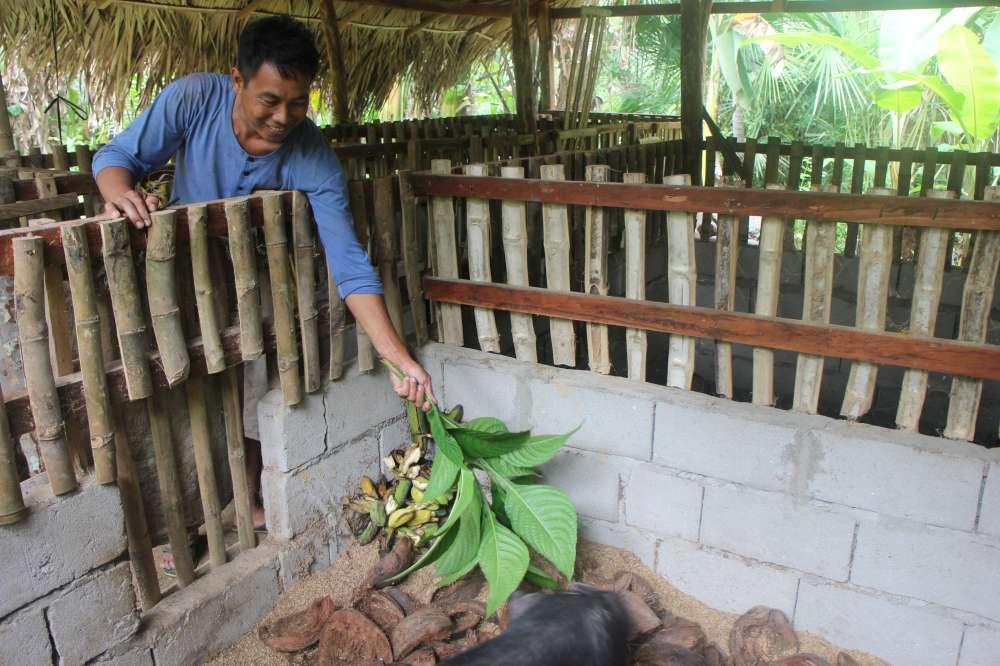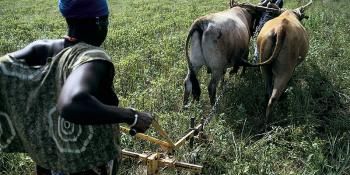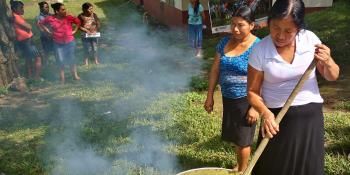Low inputs, big gains: The benefits of climate-smart livestock production

Providing farmers with multiple benefits, the reduced external input small-livestock system piloted in Guinayangan, Philippines is a good example of a climate-smart agriculture technological option.
In the municipality of Guinayangan, livestock production is one of the more reliable sources of income and food for households, especially women. Pigs and goats are being raised easily in the farmers’ backyards, helping diversify and reduce total reliance on crops. However, the changing climate, especially the rising temperatures, directly affects the growth and reproduction rates of pigs and other livestock.
To address this problem, the International Institute of Rural Reconstruction (IIRR) introduced the low external input on small-livestock system to communities in Guinayangan. Part of the Developing Scalable Approaches for Community Based Adaption project of IIRR, climate-smart agriculture (CSA) approaches, including those in livestock production, were introduced to help build farm resilience in anticipation of the impacts of climate change.
Using participatory action research methods, the activity contributes to the broader goal of the project, which is to establish an evidence base for sustainable outscaling of climate-resilient agricultural practices to enhance livelihood, resilience and adaptive capacities. The project is currently supported by the CGIAR Research Program on Climate Change, Agriculture and Food Security in Southeast Asia (CCAFS SEA).
 The farmers are required to grow their own intensive feed garden with crops such as taro, cassava, sweet potato, and water hyacinth to provide nourishment for the livestock. Photo: IIRR
The farmers are required to grow their own intensive feed garden with crops such as taro, cassava, sweet potato, and water hyacinth to provide nourishment for the livestock. Photo: IIRR
A low external input system can be climate-friendly
The low external input on small-livestock system piloted in Guinayangan requires the use of locally-produced inputs, while promoting health and productivity at the same time.
Because of their higher tolerance to higher temperatures and resistance to parasites, pests and diseases, the system relies on the use of native pigs. Native pigs also have higher economic (meat is considered by local communities as tastier, crispier, and leaner) and nutritional value (lower fat and cholesterol), providing more benefits to farmers.
Climate-smart livestock production can also reduce the carbon footprint of livestock production by emphasizing small scale, backyard systems that rely more on locally grown alternative feed sources without chemical additives. Not to rely on commercial feeds, the farmers participating in the project are required to grow their own intensive feed garden. Crops such as taro, cassava, sweet potato, and water hyacinth are being grown, not only to provide nourishment for the livestock, but also an alternative food source for the households. However, limited quantities of commercial feed are used during the first two months of pigs.
Utilising local materials like bamboo, housing structures were built to protect the pigs from the different weather conditions and the risk of contracting diseases. Coconut husks, soils, rice hull, dried leaves, and saw dust are being used to make the deep bed flooring system. Farmers observed that this practice has reduced the smell and consequently the flies, promoted the health of the pigs, and provided farms with a source of natural compost. Housing design promotes the free flow of air through the pens.
No antibiotics are used and vaccination is done only for the major diseases. In some cases, farmers use herbal supplements which cost lower. Improved native breeds, farm raised feed and housing based on native materials are key elements of this alternative approach to livestock production.
Sharing livestock assets
During the initial intervention in 2013, alternative feeds were introduced with commercial white breed pigs to six farmers in Barangay Arbismen. This was done for the farmers to adjust to new methods, which was hoped to result in the sustainability of the project and to encourage them to later switch to native breeds. In 2015, native pigs were introduced to seven farmers in Barangay Arbismen, and five each for barangays Capuluan Tulon, Ermita, and Magsaysay. Three native breeds such as Kalinga, BT Black, and Macalelon are now being raised in the area. These were sourced from the National Swine and Poultry Research Center in Quezon. Decentralised and farmer-managed multiplication and dispersal centers have been established to further improve access to better breeds of native animals.
Farmers are expected to help disseminate the idea within the community. Using pass on scheme, 47 additional farmers in four different barangays benefitted from receiving commercial pigs, and an additional 18 farmers from four barangays received native pigs. All of the original beneficiaries have shared their livestock assets with at least two other farmers, many of whom have then gone on to also share to at least one additional farmer.
 Using pass on scheme, farmers are expected to help disseminate the technology and share the benefits within the community. Photo: IIRR
Using pass on scheme, farmers are expected to help disseminate the technology and share the benefits within the community. Photo: IIRR
Because it is non-labor intensive, this livestock production system can be easily managed by women. Juliana Belmin, a mother from Barangay Arbismen, grows native pigs despite her poor leg condition. She started in January 2014 after IIRR gave her one young suckling pig each. According to her, raising native pigs helped them reduce their expenses for feeds and other materials. It also helped her with her regular medication and personal expenses such as food and supplies. The meat of the native pigs also serves as food for the household.
Fred Rosales, president of the group of native pig growers in Barangay Capuluan Tulon, also takes care of native pigs using this system. In times of emergency, selling native pigs has helped them to raise the money they need. Fred was able to buy materials for his house improvement requirement by selling one of his native pigs.
Farmer Learning Groups (FLGs) were organized to provide the beneficiaries with a platform for knowledge exchange about the breakthroughs in the action research being conducted in the community. After realising and experiencing the benefits of rearing native pigs and using of low input methods for both breeds, farmers are approaching others and showing them evidence of the positive impacts of adopting this livestock production method. At present, two FLGs are focusing on low external input pig production, such as: in Barangay Arbismen with 34 members and in Barangay Ermita with 15 members.
There are challenges for outscaling this practice. The poor lack resources to acquire high quality native breeding stocks such as those distributed by the projects. Further investments are needed for additional propagation centers. Promotional activities are needed in order to increase the community’s awareness of the climate friendliness of the low carbon footprint approaches. But the interest is growing and local communities are continuing to share the practices with other communities
To heighten interest, training on processing of meat be a future component of the project. This will help in promoting the economic and nutritional benefits of native pig production. The development of market linkages for farmer will also provide opportunities for project sustainability. Climate-smart and low carbon footprint approaches to livestock production, even on small household level scale, can contribute significantly to reducing emissions. Such approaches also help bring economic empowering CSA options to women in poor households as well.
Read more:
- CCAFS blog: Philippine community adopts climate-smart agriculture with greater involvement
- CCAFS blog: Farmers in Southeast Asia learn about climate-smart agriculture practices
- CCAFS blog: Mangroves shield communities from typhoons, storm surges
Eisen Bernardo is the Senior Communication Specialist of CCAFS Southeast Asia.



